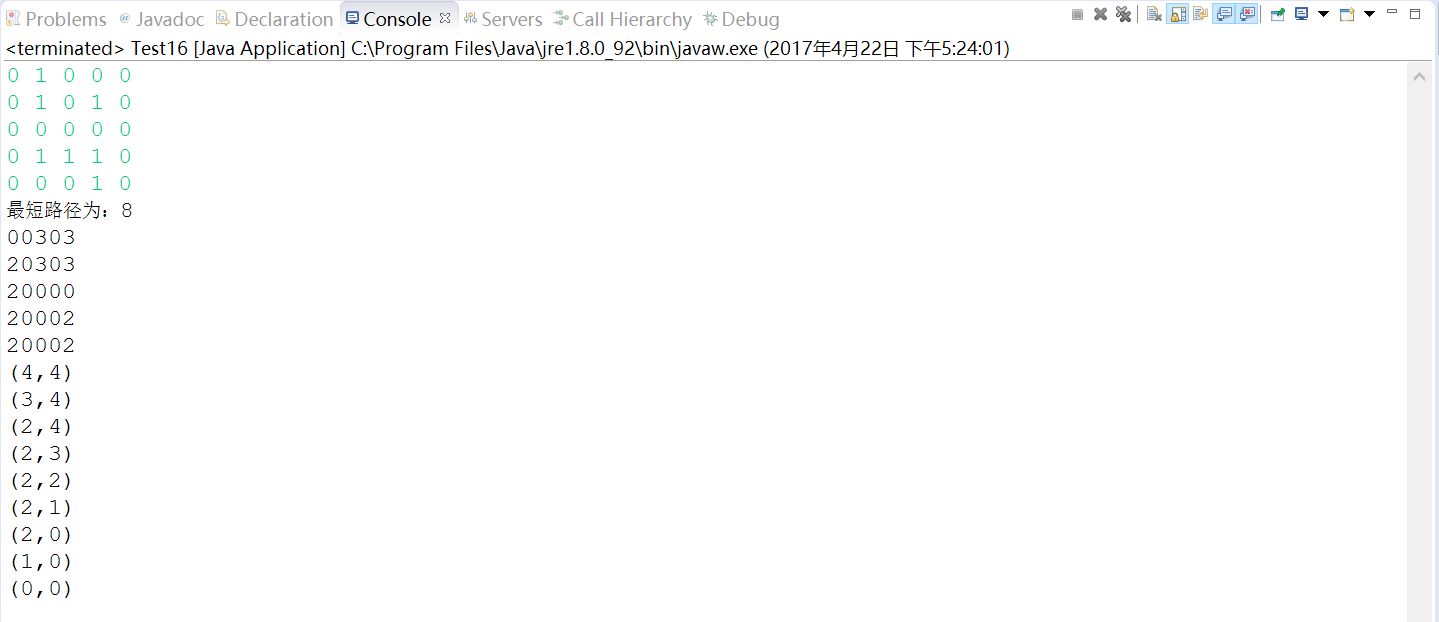BFS-迷宫问题
来源:互联网 发布:gson解析复杂的json 编辑:程序博客网 时间:2024/04/29 21:44
问题描述
定义一个二维数组: int maze[5][5] = { 0, 1, 0, 0, 0, 0, 1, 0, 1, 0, 0, 0, 0, 0, 0, 0, 1, 1, 1, 0, 0, 0, 0, 1, 0,};它表示一个迷宫,其中的1表示墙壁,0表示可以走的路,只能横着走或竖着走,不能斜着走,要求编程序找出从左上角到右下角的最短路线。
Input
一个5 × 5的二维数组,表示一个迷宫。数据保证有唯一解。
Output
左上角到右下角的最短路径,格式如样例所示。
Sample Input
0 1 0 0 00 1 0 1 00 0 0 0 00 1 1 1 00 0 0 1 0
Sample Output
(0, 0)(1, 0)(2, 0)(2, 1)(2, 2)(2, 3)(2, 4)(3, 4)(4, 4)
代码
import java.util.LinkedList;import java.util.Queue;import java.util.Scanner;import java.util.Stack;public class Test16 { // 用于记录当前节点 public static class Node { int x; int y; int step; } static int[][] migong = new int[6][6]; // 记录防止重走 static boolean[][] vsd = new boolean[6][6]; // 记录上一步情况 static int[][] pre_step = new int[6][6]; // 用于层次遍历 static Queue<Node> queue = new LinkedList<>(); public static void main(String[] args) { Scanner in = new Scanner(System.in); for (int i = 0; i < 5; i++) { for (int j = 0; j < 5; j++) { migong[i][j] = in.nextInt(); if (migong[i][j] == 1) { vsd[i][j] = true; } } } Node node = new Node(); node.x = 0; node.y = 0; node.step = 0; bfs(node); } // 思路:使用bfs思想,走到最后一步migong[4][4],不断记录上一步位置,到达最后位置后,退回去回初始位置migong[0][0],就是最短路径。 // 用变量1,2,3,4分别记录为上下左右,放进数组中用来控制变量 // 用一个数组记录上一步情况 // 用一个stack利用先进后出,输出路径 public static boolean cheak(Node node) { if (node.x >= 0 && node.x < 5 && node.y >= 0 && node.y < 5 && !vsd[node.x][node.y]) { return true; } else { return false; } } // 方向控制 static int[][] dir = { { 0, 1 }, { 0, -1 }, { 1, 0 }, { -1, 0 } }; public static void bfs(Node node) { // 使用两个node记录当前和下一个的状态 queue.offer(node); Node now; vsd[node.x][node.y] = true; Node next = new Node(); while (!queue.isEmpty()) { now = queue.peek(); // 控制方向 0右1左2下3上 for (int i = 0; i < 4; i++) { next.x = now.x + dir[i][0]; next.y = now.y + dir[i][1]; if (cheak(next)) { vsd[next.x][next.y] = true; next.step = now.step + 1; // 此处注意 一定要用零时Node加入队列中,因为java中对象是引用传递 Node tmp = new Node(); tmp.x = next.x; tmp.y = next.y; tmp.step = now.step + 1; queue.offer(tmp); pre_step[next.x][next.y] = i; } } queue.poll(); if (now.x == 4 && now.y == 4) { System.out.println("最短路径为:" + now.step); break; } } DisPlay(); } // 输出所走路径 public static void DisPlay() { Stack<Node> stack = new Stack<>(); for (int i = 0; i < 5; i++) { for (int j = 0; j < 5; j++) { System.out.print(pre_step[i][j]); } System.out.println(); } int i = 4, j = 4; System.out.println("(" + i + "," + j + ")"); while (true) { switch (pre_step[i][j]) { case 0: j = j - 1; break; case 1: j = j + 1; break; case 2: i = i - 1; break; case 3: i = i + 1; break; default: break; } System.out.println("(" + i + "," + j + ")"); if (i == 0 && j == 0) { break; } } }}

阅读全文
0 0
- POJ3984 迷宫问题 BFS
- 经典迷宫问题BFS
- 迷宫问题 bfs
- 迷宫问题BFS暴搜
- BFS | 3984 | 迷宫问题
- hncu1102:迷宫问题(BFS)
- POJ3984 迷宫问题 BFS
- poj3984 迷宫问题(BFS)
- 迷宫问题BFS
- 【BFS】迷宫类问题
- 迷宫问题bfs
- POJ3984 迷宫问题【BFS】
- BFS解迷宫问题
- BFS求解迷宫问题
- poj3984迷宫问题(bfs)
- 迷宫问题(BFS)
- POJ3984 迷宫问题【BFS】
- 迷宫问题bfs解决
- sass与scss的区别
- codeforces Pride 892C
- 二:Python发展史
- 死锁
- Centos7.0上用docker下搭建codis集群
- BFS-迷宫问题
- ElementUI案例演示:导航、布局、加载动画
- 三:Python 2 or 3?
- hdoj-1035Robot Motion
- 字典
- Java源码之ConcurrentHashMap
- 【面试】--java相关
- String类中的常用方法
- Windows下配置Caffe+Tensorflow几个非常重要的注意点和所需安装包!!


